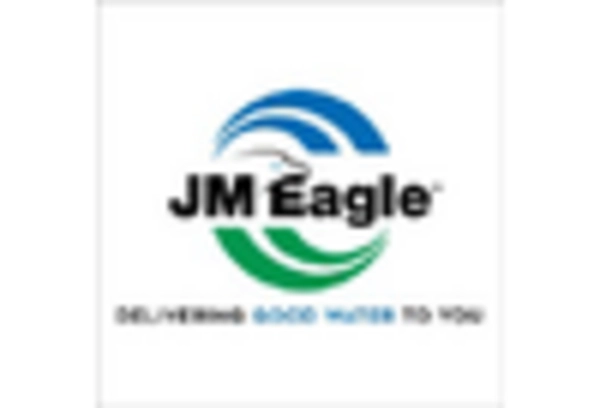Technological Innovations in Manufacturing
The plastic pipes market is experiencing a wave of technological innovations that enhance production efficiency and product quality. Advanced manufacturing techniques, such as extrusion and injection molding, are being adopted to produce high-performance pipes. These innovations are likely to reduce production costs and improve the durability of plastic pipes, making them more appealing to consumers. The plastic pipes market is expected to benefit from these advancements, as manufacturers strive to meet the growing demand for reliable and long-lasting piping solutions. Additionally, the integration of smart technologies in pipe manufacturing could further streamline operations and enhance product offerings.
Agricultural Expansion and Irrigation Needs
China's agricultural sector is undergoing significant transformation, with a focus on enhancing irrigation systems to improve crop yields. The government aims to increase agricultural productivity by 20% by 2027, which is likely to drive demand for plastic pipes. These pipes are essential for modern irrigation techniques, such as drip and sprinkler systems, which are becoming increasingly popular among farmers. The plastic pipes market stands to gain from this agricultural expansion, as farmers seek efficient and sustainable solutions to manage water resources. With approximately 60% of China's water resources allocated to agriculture, the need for reliable irrigation infrastructure is paramount, further propelling the market.
Urbanization and Infrastructure Development
The rapid urbanization in China is a primary driver for the plastic pipes market. As cities expand, the demand for efficient water supply and drainage systems increases. The government has invested heavily in infrastructure projects, with an estimated $1 trillion allocated for urban development by 2030. This investment is likely to boost the plastic pipes market, as these materials are favored for their lightweight, corrosion-resistant properties. Furthermore, the urban population is projected to reach 1 billion by 2030, necessitating advanced plumbing solutions. The plastic pipes market is expected to benefit from this trend, as municipalities seek durable and cost-effective piping solutions to support growing urban populations.
Environmental Regulations and Water Management
China's stringent environmental regulations are shaping the plastic pipes market. The government has implemented policies aimed at reducing water waste and improving water quality, which necessitates the use of advanced piping systems. The plastic pipes market is likely to see growth as industries and municipalities comply with these regulations. For instance, the Ministry of Ecology and Environment has mandated that by 2025, 80% of urban wastewater must be treated, creating a demand for high-quality plastic pipes that can withstand corrosive environments. This regulatory landscape encourages the adoption of plastic pipes, which are often more resistant to chemical degradation compared to traditional materials.
Rising Construction Activities and Housing Demand
The construction sector in China is witnessing a resurgence, driven by increasing housing demand and government initiatives to boost the economy. With a projected growth rate of 5% in the construction industry by 2026, the plastic pipes market is poised for expansion. Plastic pipes are favored in residential and commercial construction due to their lightweight nature and ease of installation. The plastic pipes market is likely to thrive as builders and contractors seek efficient solutions to meet the rising demand for housing. Furthermore, the government's focus on affordable housing projects is expected to further stimulate the market, as these projects often utilize cost-effective materials like plastic pipes.

















Leave a Comment